Edward II of England Worksheets
Do you want to save dozens of hours in time? Get your evenings and weekends back? Be able to teach about Edward II of England to your students?
Our worksheet bundle includes a fact file and printable worksheets and student activities. Perfect for both the classroom and homeschooling!
Resource Examples
Click any of the example images below to view a larger version.
Fact File
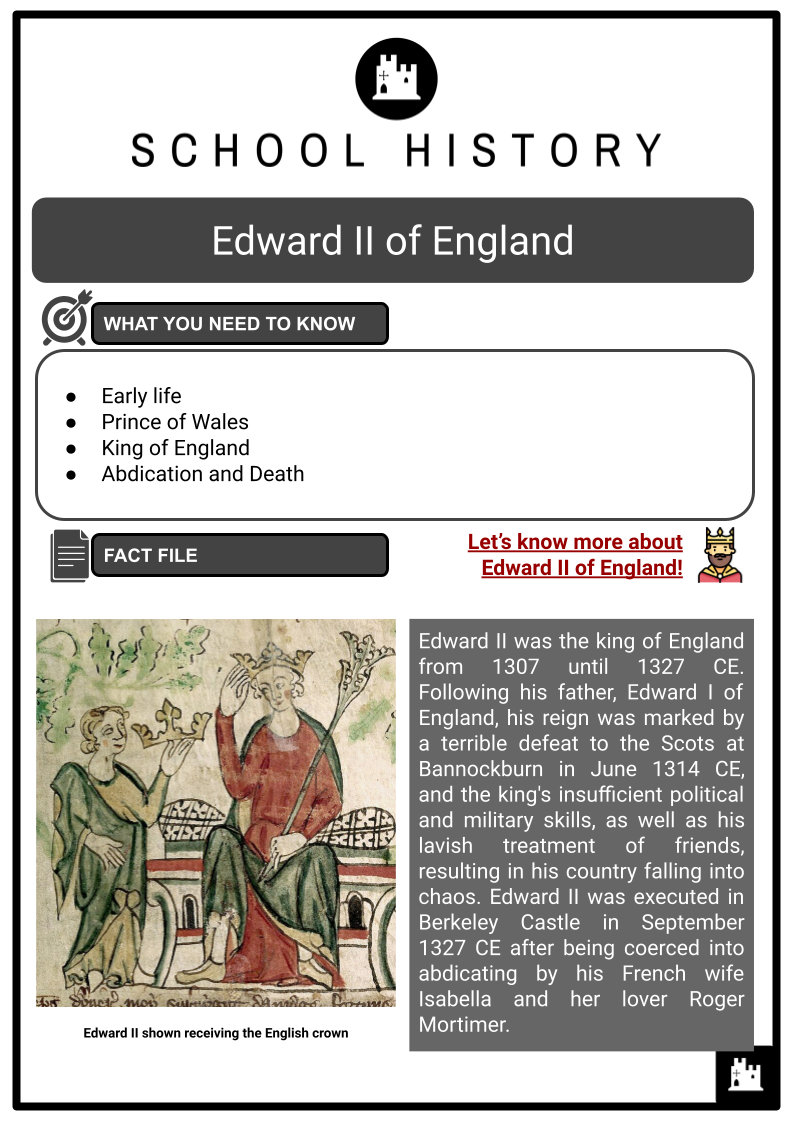
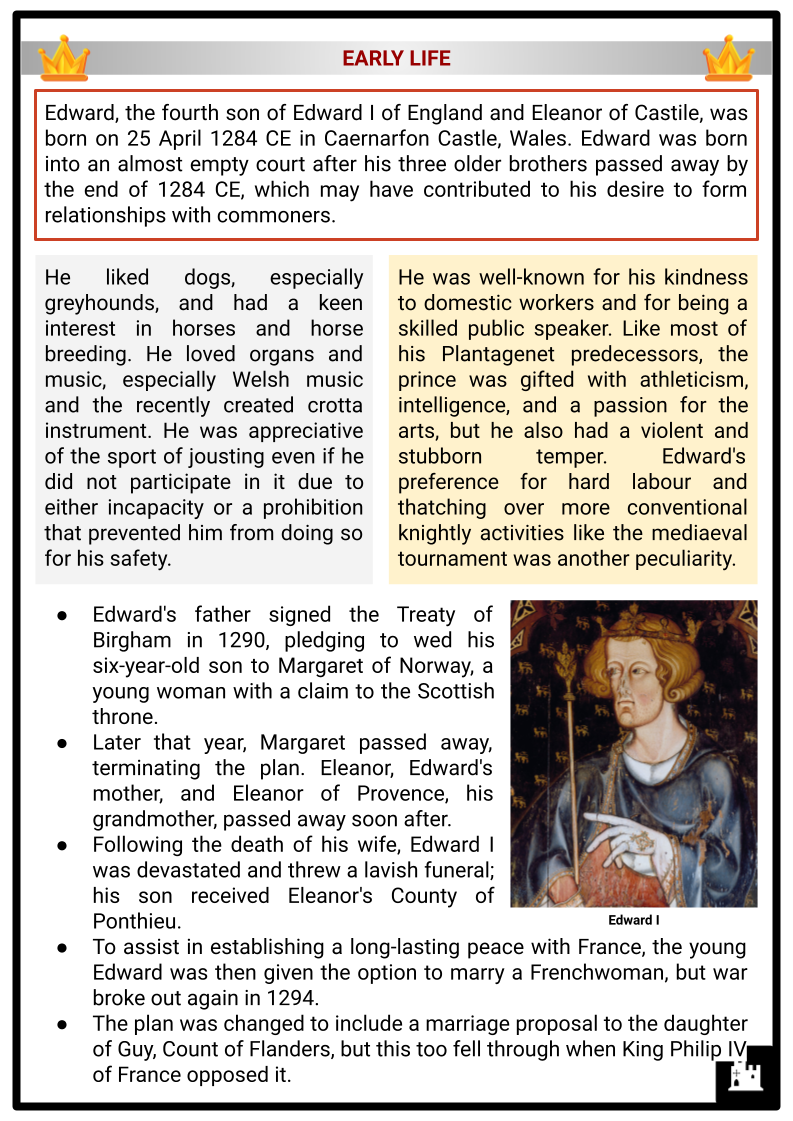
Student Activities
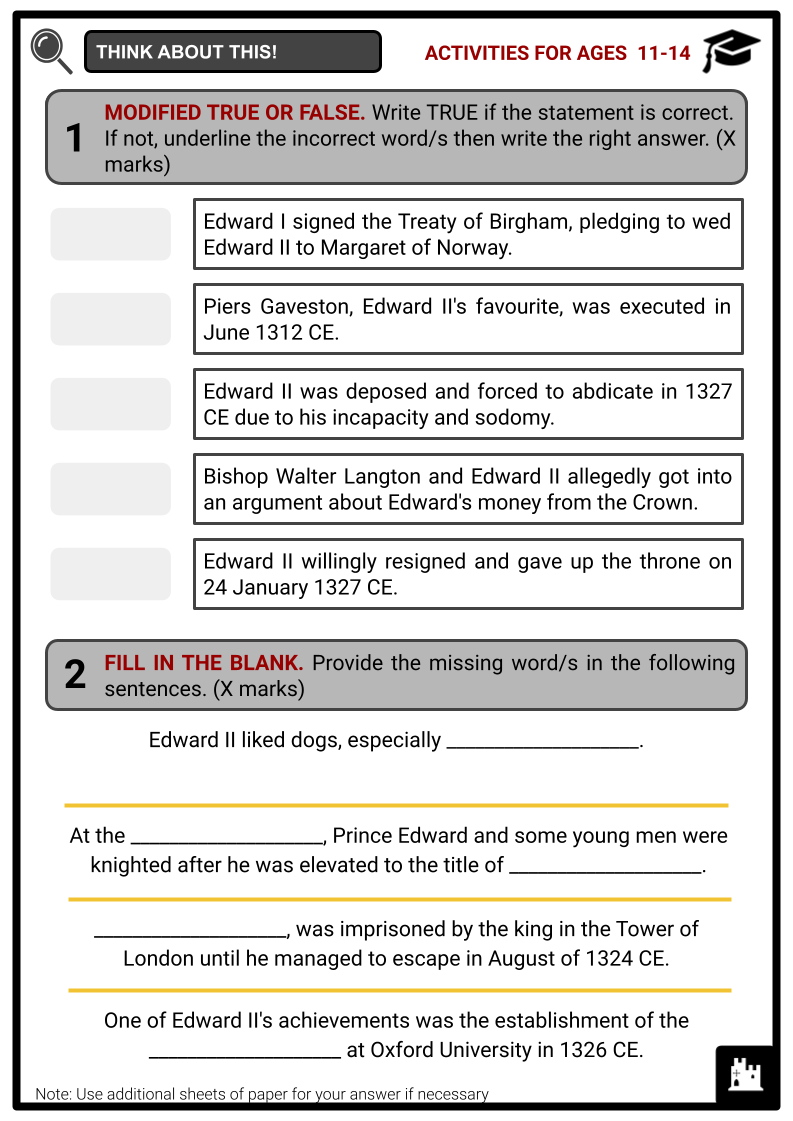
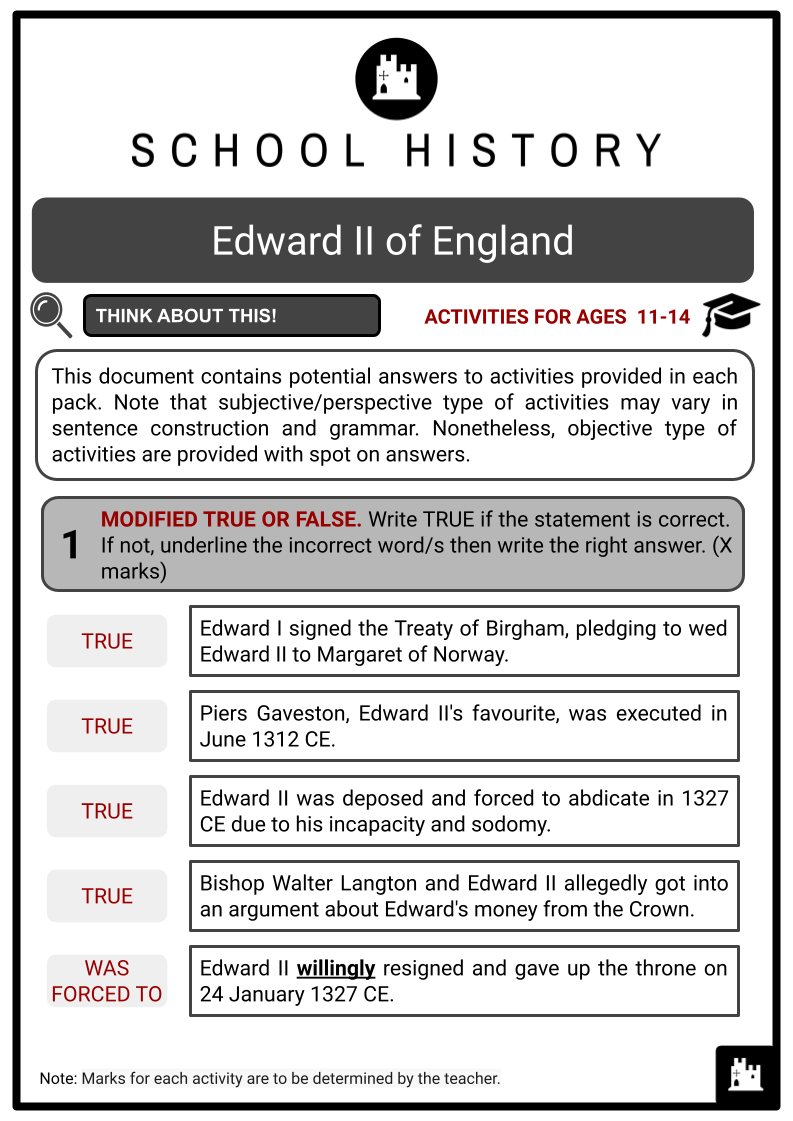
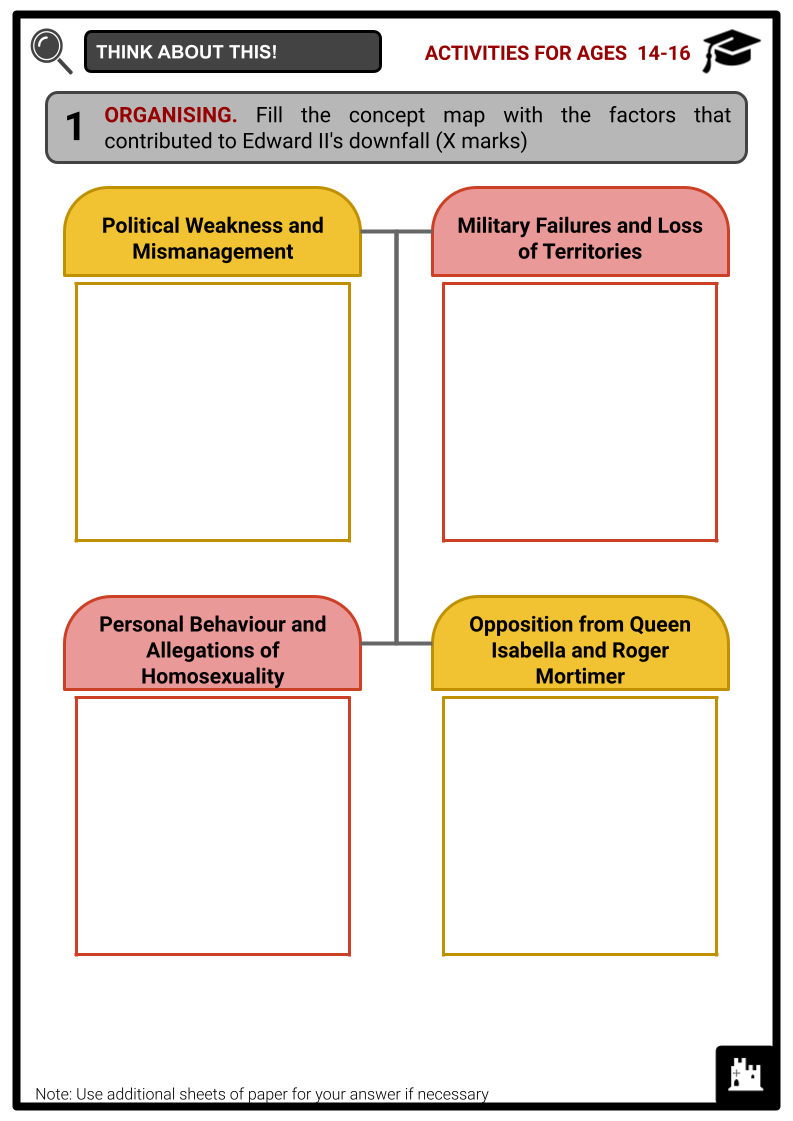
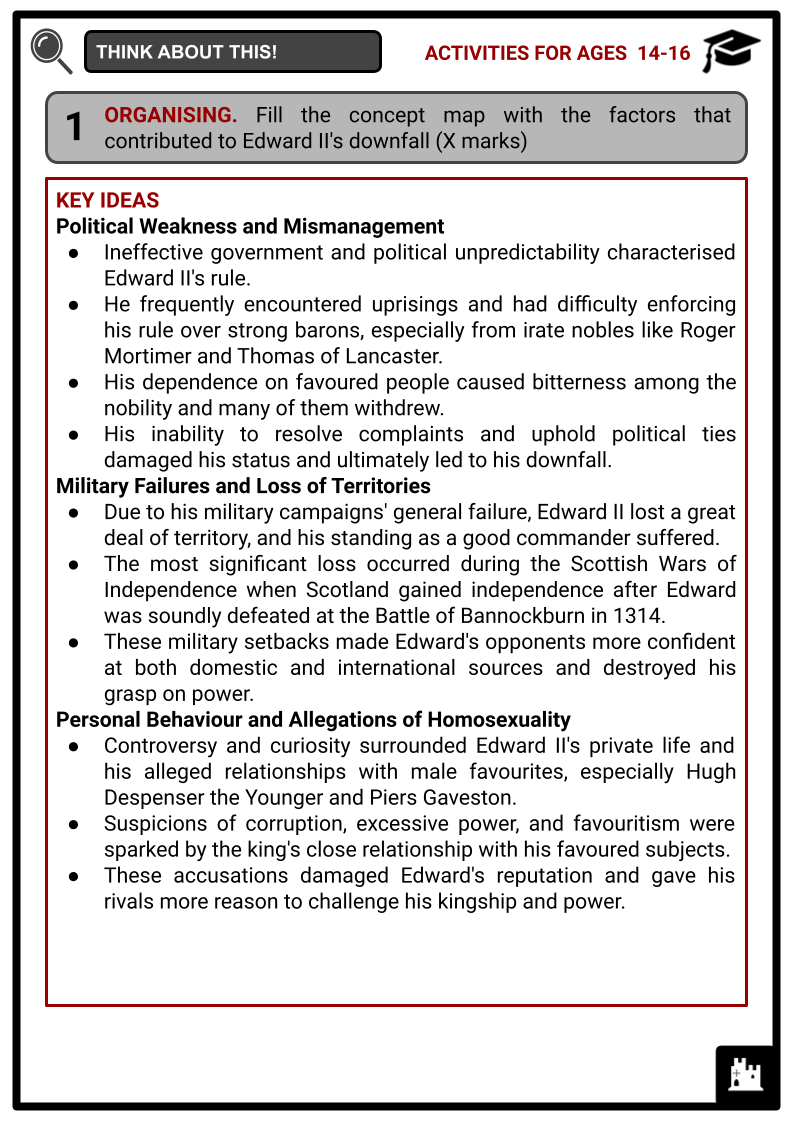
Summary
- Military Training Act 1939
- UK declaration of war on Germany
- National Service Act 1939
Key Facts And Information
Let’s know more about Edward II of England!
Edward II was the king of England from 1307 until 1327 CE. Following his father, Edward I of England, his reign was marked by a terrible defeat to the Scots at Bannockburn in June 1314 CE, and the king's insufficient political and military skills, as well as his lavish treatment of friends, resulting in his country falling into chaos. Edward II was executed in Berkeley Castle in September 1327 CE after being coerced into abdicating by his French wife Isabella and her lover Roger Mortimer.
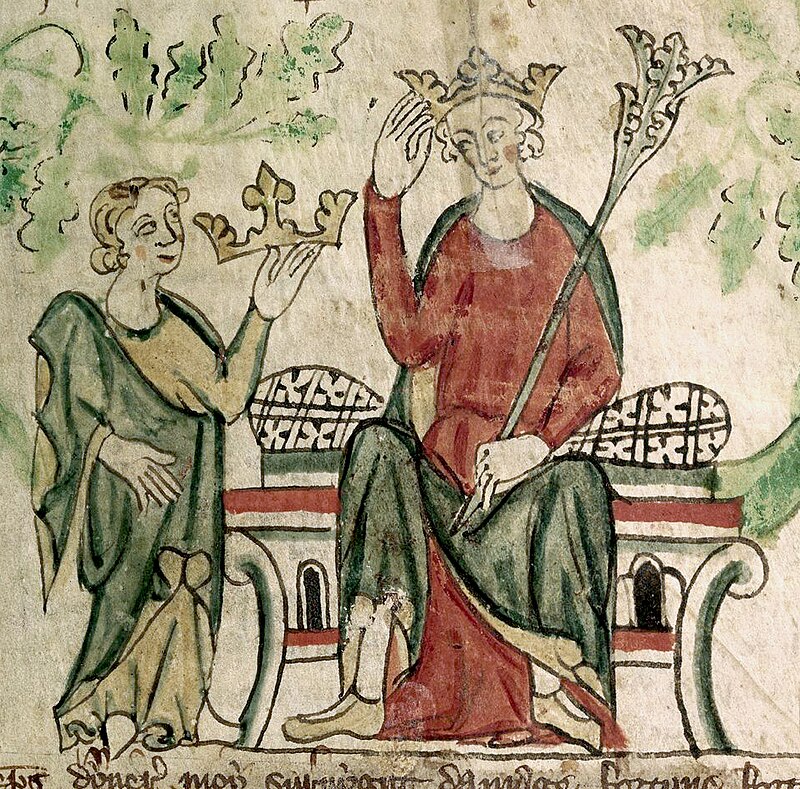
EARLY LIFE
- Edward, the fourth son of Edward I of England and Eleanor of Castile, was born on 25 April 1284 CE in Caernarfon Castle, Wales. Edward was born into an almost empty court after his three older brothers passed away by the end of 1284 CE, which may have contributed to his desire to form relationships with commoners.
- He liked dogs, especially greyhounds, and had a keen interest in horses and horse breeding. He loved organs and music, especially Welsh music and the recently created crotta instrument. He was appreciative of the sport of jousting even if he did not participate in it due to either incapacity or a prohibition that prevented him from doing so for his safety.
- He was well-known for his kindness to domestic workers and for being a skilled public speaker. Like most of his Plantagenet predecessors, the prince was gifted with athleticism, intelligence, and a passion for the arts, but he also had a violent and stubborn temper. Edward's preference for hard labour and thatching over more conventional knightly activities like the mediaeval tournament was another peculiarity.
- Edward's father signed the Treaty of Birgham in 1290, pledging to wed his six-year-old son to Margaret of Norway, a young woman with a claim to the Scottish throne.
- Later that year, Margaret passed away, terminating the plan. Eleanor, Edward's mother, and Eleanor of Provence, his grandmother, passed away soon after.
- Following the death of his wife, Edward I was devastated and threw a lavish funeral; his son received Eleanor's County of Ponthieu.
- To assist in establishing a long-lasting peace with France, the young Edward was then given the option to marry a Frenchwoman, but war broke out again in 1294.
- The plan was changed to include a marriage proposal to the daughter of Guy, Count of Flanders, but this too fell through when King Philip IV of France opposed it.
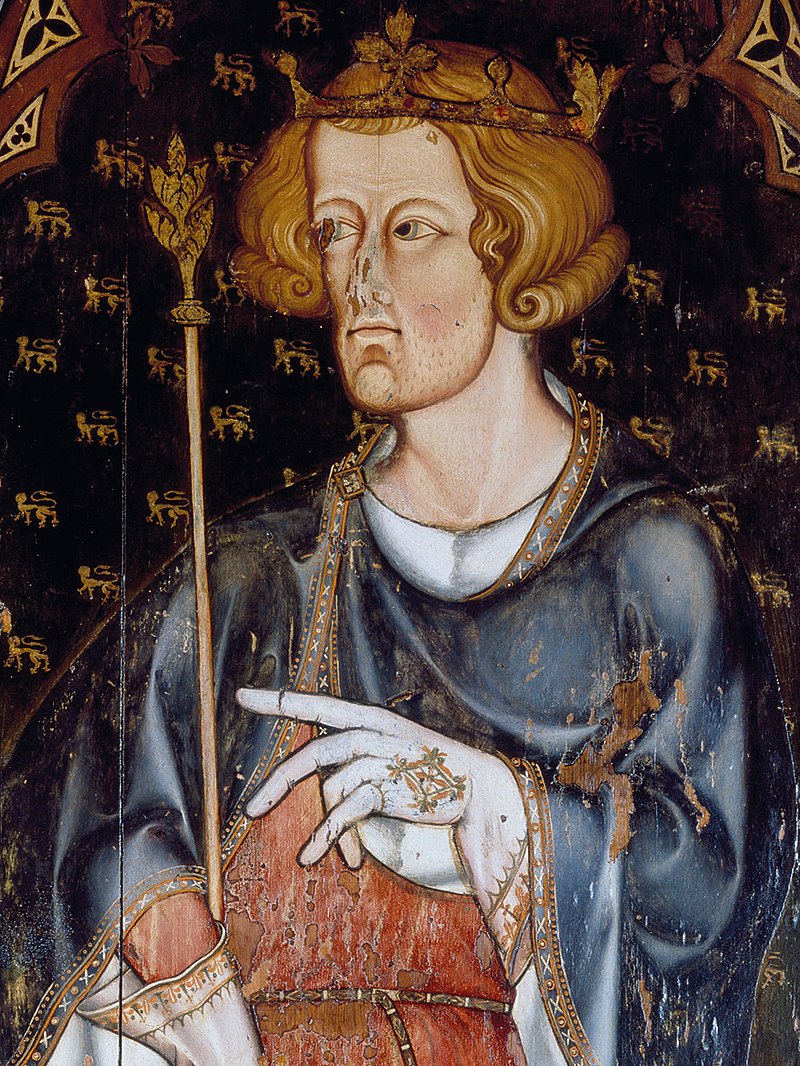
- Edward I was left in charge of England as regent between 1297 and 1298 while the king fought Philip IV in Flanders, who had taken over some of the English king's lands in Gascony. Upon his return, Edward I signed a peace treaty, in which he agreed to marry Philip's sister Margaret and that Edward II would eventually wed Philip's daughter, Isabella, who was just two years old at the time.
PRINCE OF WALES
- As the oldest surviving son of an English monarch to receive this title – a practice that is being carried on to this day – Edward was formally named Prince of Wales by his father in 1301 CE.
- After receiving respect from his Welsh countrymen, Edward went north with his father to participate in the 1301 Scottish expedition. Together, they seized Turnberry Castle. In the 1303 expedition, Prince Edward also participated in the capture of Brechin Castle, using his siege engine in the process. Edward represented the king in discussions with the rebel Scottish chiefs in the spring of 1304, and when those failed, he went to Stirling Castle to take over his father.
- Edward and his father had a falling out around 1305, most likely about money. The prince got into a fight with the royal treasurer, Bishop Walter Langton, reportedly about how much money Edward received from the Crown. In addition to banishing Prince Edward and his friends from his court and stopping their financial assistance, the king stood up for his treasurer. The two men eventually reconciled.
- When Robert the Bruce slaughtered his foe John Comyn III of Badenoch and proclaimed himself King of the Scots in 1306, the Scottish struggle erupted once more. Edward I raised a new army and said that his son would lead the mission officially this time. Following his elevation to the title of Duke of Aquitaine, Prince Edward and several other young men were knighted during a sumptuous event held at Westminster Abbey known as the Feast of the Swans.
KING OF ENGLAND
- At the age of barely 23, Edward II was crowned at Westminster Abbey on 25 February 1308 CE. His remarkable height seemed to be the one thing he had in common with his warrior-king father, but otherwise, his reign would be catastrophic. Because the young king lacked the stomach for battle and disregarded his father's intentions to carry on with the conflicts in Scotland, King Robert was able to gradually destroy the castles held by the English in his realm and launch frequent assaults into northern England that seemed to happen at random.
- Edward did not bring an army to Scotland until 1314 CE when he did so to capture Stirling Castle, which was held by the English. Robert the Bruce's forces were outnumbered by Edward's force (15–20,000 men against 10,000), but Bruce chose a shallow ford as the site of the engagement, negating Edward's advantage and the mobility of his 2,000 heavy cavalry. On 23 and 24 June 1314 CE, Edward faced a crushing loss in the Battle of Bannockburn, from which the monarch only just managed to escape. Robert proceeded to assault northern England after Scotland had essentially regained its independence, coming dangerously close to taking York in 1319 CE.
- Edward II largely spent his time with his pleasure-seeking associates among the amenities and sights of London, leaving foreign concerns to handle themselves. Among these friends was Piers Gaveston, also known as Peter de Gabaston, who had become the Earl of Cornwall despite coming from lowly beginnings as the son of a simple knight.
- Although historians cannot agree on whether Edward and Gaveston were homosexual partners, Edward was certainly given special treatment when he gave Gaveston the earldom, one of the greatest landholdings and a title often given to the sons of reigning kings.
- Despite the true nature of the connection between the two men, Edward followed tradition and set up the marriage of his niece Margaret de Clare to his close friend. Furthermore, on 25 January 1308 CE, the king wed Isabella, the daughter of Philip IV of France, forging an important diplomatic relationship that resulted in the birth of Edward, the heir, on 13 November 1312 CE, and three more children thereafter.
- Galveston served as the king's regent while the king was away marrying Isabella in France. His arrogant demeanour and actions angered most people, and when Edward returned to England, they practically banished him to Ireland. Gaveston's exile was short-lived as Thomas, Earl of Lancaster, who had together with a group of influential barons specifically to remove the disruptive earl from the realm, finally put him in jail and executed him in June 1312 CE.
- In September 1311 CE, 21 Ordainers were appointed to oversee the realm's justice and finances. Lancaster and his allies were eager to publicly limit the king's powers and bolster Parliament's authority. The barons further demanded that royal appointments be scrutinised going forward, that wars could only be fought with their approval, and that the Crown no longer appoint local sheriffs.
- Edward's kingdom was divided between factions supporting and opposing his incompetent ruler. Hugh le Despenser, the king's new favourite after Gaveston, headed the former, while Lancaster led the latter.
- The split even resulted in a full-scale conflict, with the royalists routing a rebel force in Yorkshire's March 1322 CE Battle of Boroughbridge.
- Edward immediately called a parliament in York to eliminate any restrictions he perceived on his royal power and had Lancaster killed (the unfortunate earl had an incompetent axeman who required three strikes to accomplish the crime).
- Everyone thought to have backed Lancaster was persecuted and exterminated, but an effort to invade Scotland was met with another humiliating loss, forcing the king to escape to York for his life. Edward had a talent for picking the wrong allies, and his military setbacks were hardly indicative of a mediaeval ruler.
ABDICATION AND DEATH
- Edward had an opponent far closer than he realised, unfortunately. A rope ladder allowed one of the anti-royalist leaders, Roger Mortimer, who had been detained by the king in the Tower of London, to escape in August of 1324 CE. Isabella, the wife of Edward, eventually fell in love with Mortimer as her marriage with Edward II was already failing. They both moved to France, where Edward and Philip V had been at battle for possession of Gascony from the beginning of 1324 CE.
- According to legend, the queen wore black and a veil after that to show that, even though her husband had not passed away yet, their marriage most definitely had. Importantly, when Isabella got rid of her husband, she had Edward's teenage heir with her, who could be set up as an easily controlled puppet monarch. For that very reason, an army of mercenaries was mustered, and in September and October of 1326 CE, it landed at Orwell, Suffolk, England.
- Even though the invading force only included 1,500 soldiers, Edward was unable to respond because his allies had turned against him and it was now obvious that his barons were eager for a change.
- Edward originally escaped to South Wales as Isabella established her court in Gloucester, but in the end, the former king was apprehended and imprisoned in Gloucestershire, first at Berkeley Castle and subsequently at Kenilworth Castle.
- Edward was forced to publicly resign on 24 January 1327 CE, with his captors using a variety of justifications, from incapacity to sodomy, to justify their right to deprive him of his divine power.
- After the young Prince Edward was crowned king, Hugh le Despenser was brutally executed as a traitor by being hung, drawn and quartered as part of Edward II's entourage purge.
- Amid all the sorrow, Edward's reign had seen some success. The economy of France was immensely improved by the large growth in exports, particularly wool, and in 1326 CE the monarch established Oriel College at Oxford University. Nevertheless, these were insignificant issues in comparison to the humiliating activities of his inner court and the losses in Scotland.
- One of the worst manifestations of the king's unpopularity may have been the declaration made one day at court by John Powderham, an Exeter tanner, who claimed to be the legitimate king and gave the reason that he had been traded for Edward the impostor when he was a baby. That people were prepared to give this credibility was evidence of just how short Edward fell of people's expectations as to how a true monarch should conduct themselves and what qualities for rulership they should have received from their forebears.
- At Berkeley Castle keep, which had become his jail, 43-year-old Edward II was assassinated on 21 September 1327 CE.
- His wife Isabella and her lover Roger Mortimer, who soon became weary of the rumours and schemes by the old king's adherents to reclaim his throne, most certainly gave the order for his death.
- Edward was deprived of food to make it appear that he had died naturally, but he clung to life persistently.
- If subsequent mediaeval historians are to be believed, the next approach used was more effective but also far more cruel: a red-hot iron rod was thrust up into the former king's guts.
- Edward, however, was put to death, and at least received a respectable funeral at Gloucester Cathedral.
- The historical drama Edward II by Christopher Marlowe immortalised Edward II's cruel rule and sticky comeuppance, solidifying the king's reputation as one of England's worst kings of all time.
Frequently Asked Questions
- Who was Edward II of England?
Edward II was the King of England from 1307 until he was forced to abdicate in 1327. He was the son of King Edward I and succeeded his father to the throne.
- What led to Edward II's downfall?
Several factors contributed to Edward II's downfall, including his ineffective rule, unpopular favourites, foreign policy failures, and inability to manage the barons' discontent.
- Was Edward II deposed?
Edward II was forced to abdicate the throne in 1327 by a barons led by his wife, Queen Isabella, and her lover, Roger Mortimer.
